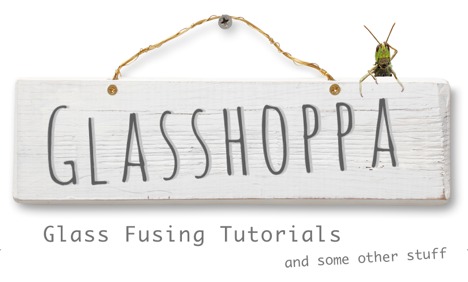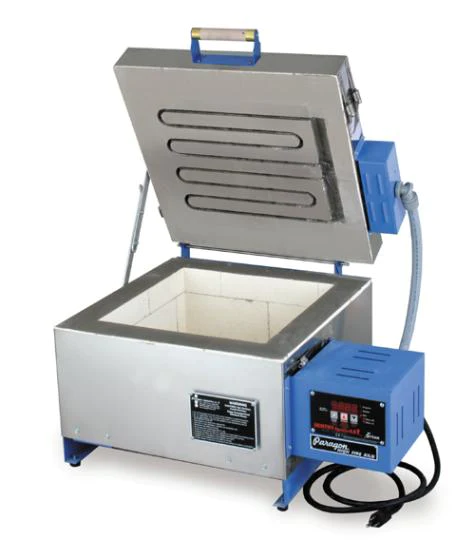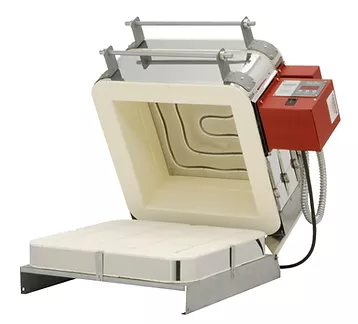Surprisingly, one of the questions I get most often is some version of this: “I am shopping for my first kiln … What would you recommend?”
To answer that, I need to make a few assumptions. Since this is a first kiln and they're asking this of the Glasshoppa, I have to assume the question is coming from a relative beginner. But who knows what their fusing future might hold? In five years they could be a high-production glass artist or a highly-stressed parent with a barely-used kiln. I also assume that if this beginner had some vision of where they wanted to go in the art form they would be clearer on their kiln needs. That said, here is how I respond:
I recommend they start with a small (but not tiny) kiln that plugs into any household outlet and comes with a programmable controller. This class of kiln usually accommodates a thirteen to fifteen inch (33-38 cm) shelf and at least a twelve inch (30.5) square or circle of glass. They are usually top-fired (heating elements in the lid only), with a chamber depth of around 6 inches (16 cm), and they max out at about 1700 degrees F (925 C)
Here is my reasoning:
1. The size accommodates a large majority of the projects most of us enjoy making.
2. There is no need for new wiring or circuitry or even a house call from the electrician. Just plug it in.
3. It is easy to relocate.
4. It is less expensive to purchase and to operate.
5. If, after a few years, interest wanes, this is probably the easiest class of kiln to resell.
6. If the fuser's needs “outgrow” this kiln, they will probably choose to keep it even after investing in a larger one.
In my experience, there is always a place for a small kiln. The larger the kiln the more costly it is to operate and the longer it takes to cool down after firing. Firings are not always full loads or large projects. For making components (pebbles, puddles, frit lace, etc.), for trying new ideas on a small scale, or for running “small loads” of anything, a small kiln is as handy in the studio as a microwave is in the kitchen.
Other than the obvious, here’s what you sacrifice when you choose one of these small kilns:
1. Depth. Six inches is great for fusing and slumping almost every glass project you're likely to make. But certain designs and techniques require (or benefit from) greater vertical space: drapes over molds taller than about 4 inches (10 cm), pot or screen melts, and drop-slumps.
2. Shelf Stacking. With heating elements only in the lid, stacking shelves to add capacity will result in uneven heating.
3. “Touchpad” controller. Most of these small kilns come equipped with 3-button controllers — that is, you have to scroll through the digits to reach your settings rather than just enter them. It’s an inconvenience, and frustrating when you're in a hurry or your mind is wandering, but that's all. Of course you can upgrade to a more full-featured controller, but that's a big expense.
Other considerations:
Digital controller: You may be attracted to a kiln equipped with only an infinity switch (off-low-med-hi settings) because of the price, but believe me, you want the digital controller. This technology is arguably the tool that made glass fusing accessible to the common crafter like you and me. Without it you're a slave to your project. Don't get me wrong, it is perfectly possible to be a successful fuser with an infinity-switch equipped kiln, it just requires a lot more time and effort.
Lid construction: a ceramic fiber lid is preferable to a brick one, though this feature is not commonly available in the smaller, less expensive kilns. Firebrick is very soft and heating elements expand and contract during firing. It is not unusual for bits of brick to loosen and fall from the kiln ceiling during firing, usually onto your work! Those of us with top-firing brick-lidded kilns are accustomed to using a shop-vac on the lid element channels periodically to keep it clean.
Element mounting: look for a kiln whose elements do not require steel pins to be held in place.
Solid state relay: mechanical relays are usually the first thing to go. Choose solid state.
© 2022 Glasshoppa Glass Arts LLC • all rights reserved


